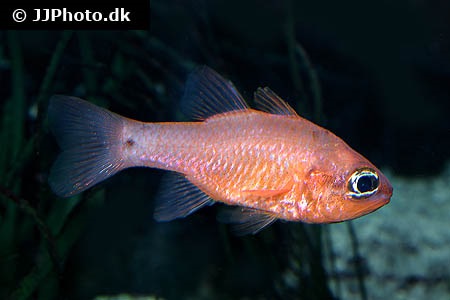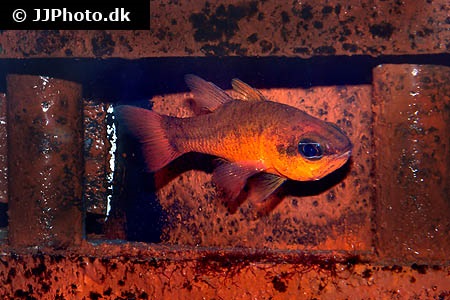Apogon imberbis


| Latin name | Apogon imberbis |
|---|---|
| Local name | Mediterranean cardinalfish |
| Family | Apogonidae - Apogon |
| Origin | Mediterranean Sea |
| Max length | 15 cm (5.9") |
| Minimum volume |
200 l (53 gal) |
|---|---|
| Hardiness |
Average |
| Suitable for aquarium |
Suitable for special aquariums |
| Reef safe |
Always reef safe |
| Aggressiveness | Docile but might be aggressive towards similar species |
| Recommended |
Small crustaceans (Krill, mysis, artemia...) Zooplankton (Cyclops, pods...) |
|---|---|
| Maybee |
Larger crustaceans (Shrimp, crabs...) |
This spicies might be a threat to smaller fishes.
This species can be a threat towards small crustaceans, e.g. small shrimp.
This species lives in water colder than is the norm for a marine aquarium.
The temperature should be between 18 and 21 °C (64 and 70 °F).
This species is very sensitive during transportation and acclimatizing into the aquarium.
In the aquarium the colour of this species can become matte.
Food with plenty of pigment and generally a varied diet of high quality can help alleviate colour loss.
A very secretive species which hides between the rocks.
When it feels at home in the aquarium it will appear more, but is still not as active in the water column as most of the other fish.
This species can function in large numbers down to just one.
This species needs good hiding places, for example, between live rocks.
This species is nocturnal and therefore the most active when the light is dimmed or turned off.
Cardinalfish come in many different shapes and colours, generally they are well suited for aquaria.
Cardinalfish have a large mouth and a big appetite, take this into account with feeding the other fish. These fish typically live off of Artemia, Mysis and krill. In the aquarium they will eat anything they can.
They will sometimes eat small shrimps and fish, so do be aware of this, but it is not normally a problem.
It is possible to keep several species together, if space allows. Some species will form small shoals. They are normally peaceful towards other fish, but will sometimes fight among themselves if there isn't sufficient space or food.
Many species are nocturnal and will therefore often seek a hiding place during the day. This can be between stones, SPS corals and, in some cases, in an anemone and between spines of Sea urchins.
Cardinalfish are a good choice if ones wishes to attempt to start a breeding tank.
Scott W. Michael. 2001. Basslets, Dottybacks & Hawkfishes: v. 2 (Reef Fishes) - TFH Publications / Microcosm Ltd. - (English)
Bob Fenner. Cardinalfishes, Family Apogonidae, Pt. 1, Pt. 2 - Wet Web Media - (English)

